817 Search Results for praactical teaching
January 15, 2013
by Carole Zangari -
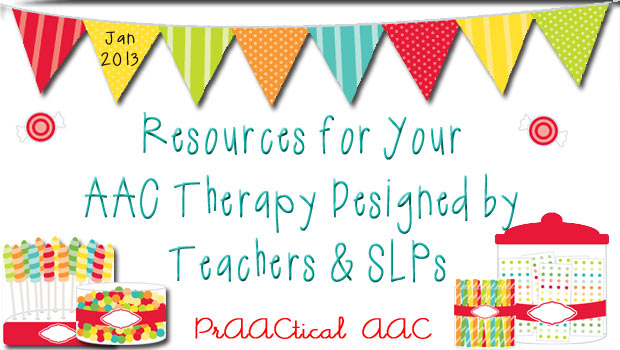
2012 was certainly the year that saw an explosion of SLPs and teachers authoring materials that they offer for sale. TeachersPayTeachers (TpT) is one of several sites that became popular this year and is credited with giving a huge boost to the movement. Here are some of prAACtical interest. Kate Ahern’s Core Word Boards: This set of communication boards can be a big timesaver for anyone who wants to implement a core word approach and needs help in getting set up with some initial materials. (17 pp) Fun for Learning’s visual support with a Star Wars Theme. Use this (or one of her other thematic kits) to customize picture schedules and supports based on the learner’s area of interest. (Free) Working on semantics? This PowerPoint template for making vocabulary teaching supports from Jerilyn can be used to provide practice. (Free) Teaching interrogatives is something that most of us don’t... [Read More...]
January 14, 2013
by Robin Parker -
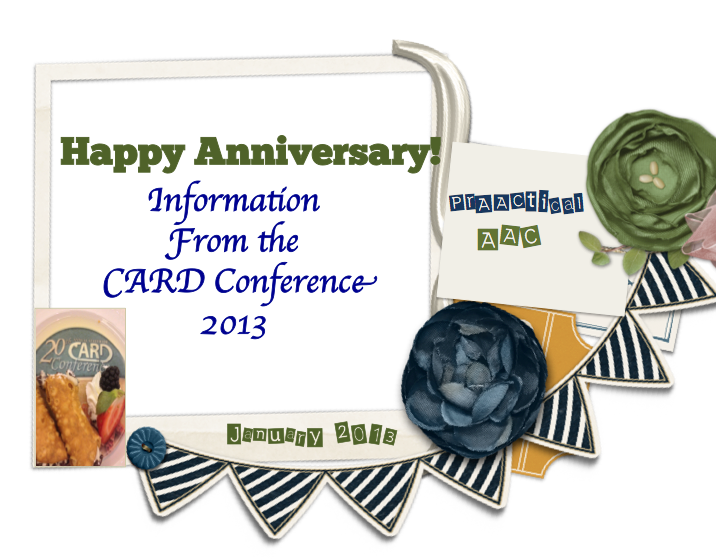
It was more than 20 years ago when the idea of a Florida Statewide Autism Resource Center was formed. This weekend marked the 20th Anniversary Celebration Conference of that unique and progressive vision. The Center for Autism & Related Disabilities (CARD) was created and flourishes through the collaboration of so many dedicated and energetic parents and professionals. Today, CARD is known as ‘Florida’s First Choice for Autism Support’. What is CARD? CARD is a comprehensive outreach and support program serving people with autism and related disabilities, their families, and the professionals who work with them. CARD seeks to provide support and assistance with the goal of optimizing the potential of people with autism, dual sensory impairment, and related disabilities. CARD is a Florida State Grant Program that provides all services at NO COST to the people who use them. The CARD Conference This years CARD conference was at the beautiful... [Read More...]
January 12, 2013
by Carole Zangari -
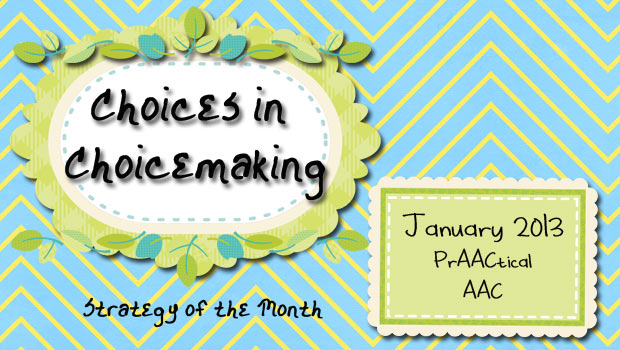
Choicemaking and requesting may be the most frequently targeted areas for beginning communicators who are starting out with their AAC systems. That makes sense for some learners because making choices is a very concrete focus for interaction and is loaded with motivational power. It seems pretty straightforward but, like anything else we do clinically, there are lots of decisions and choices to be made as we delve deeper into the process. How can we craft an AAC system that targets requesting for now, but also supports core language learning? For communicators who are at the earliest stages of making requests with AAC symbols, the strategy we discussed earlier this month or simple choice boards are a good starting point. But unless we quickly address where this is all going, the client will be strictly limited in their language learning. There are many ways to do this. Here is one approach.... [Read More...]
January 7, 2013
by Carole Zangari -
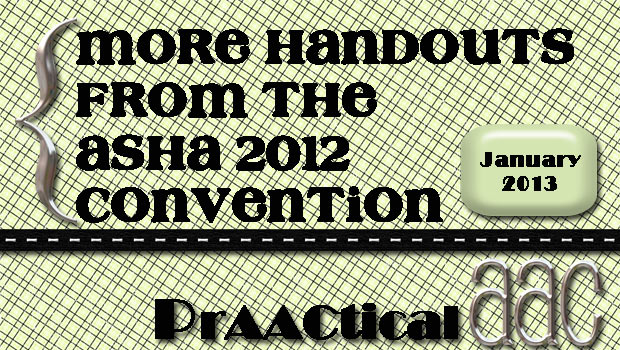
Getting to conferences to hear about new developments in AAC is always re-energizing. Here are some of the handouts from ASHA’s 2012 Convention in Atlanta. Edwin and Esther Prentke AAC Distinguished Lecture: Education, Empowerment, and Employment of People Who Use AAC by Jennifer Lowe Using AAC Device-Generated Data to Develop Therapy Sessions by Russell Cross Analyzing Language Development Physically Impaired Children Using AAC Devices by Moniks Ortloff, Paul Andres, Meher Banajee, and Gail Van Tatenhove Teaching Children to Produce Novel Multi-Symbol Questions/Statements via AAC Apps by Jennifer Kent-Walsh, Cathy Binger, Pamela Resnick, and Carolyn Buchanan The App Revolution: Where Are We in the Evolution? by Elizabeth (Libby) Rush and Celeste Helling
January 4, 2013
by Carole Zangari -
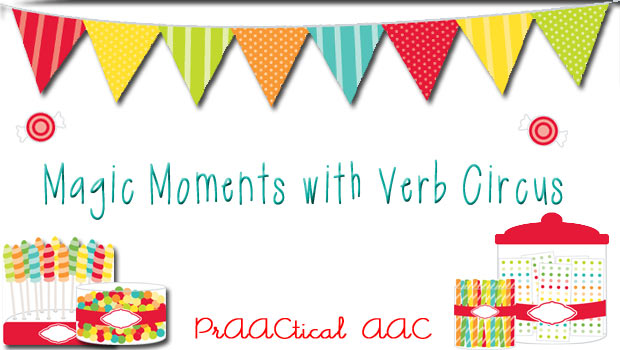
We are so excited to see the expanded web presence by SLPs who are blogging, running groups on Facebook, sharing resources on Pinterest, and maintaining online stores on TeachersPayTeachers. We’ve been thinking about how to connect with some of these creative professionals, both to extend our own professional learning networks and also to broaden the reach of our AAC message. Recently, when an opportunity to forge a few connections presented itself, we decided to collaborate with a few new SLP friends. Periodically, we will be featuring the materials of a fellow SLP who typically writes for colleagues serving primarily children with high incidence disabilities. They post great ideas and materials for students with articulation and phonological difficulties, fluency problems, and language disorders. We hope to put a prAACtical spin on their great ideas. In our inaugural post of this type, we hope to inspire some Magic Moments with fellow SLP Jocelyn... [Read More...]
January 3, 2013
by Robin Parker -
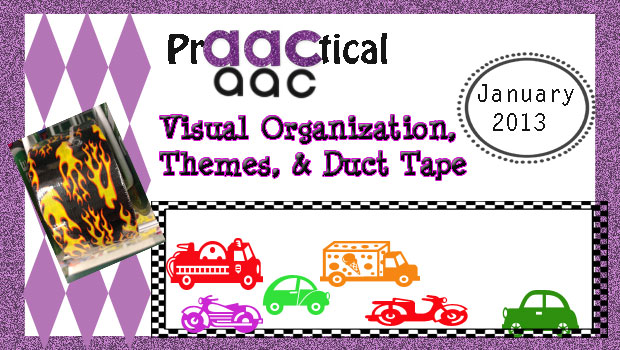
Duct tape just keeps getting better. For full transparency and disclosure, we get nothing and receive nothing from the makers or licenses of any brand of duct tape. We only buy it (although sometimes it might be on sale). We have written about duct tape as a prAACtical behavior strategy, but since that time, the popularity of duct tape as a crafting tool has increased. We are excited not because of the crafting opportunities but instead because we see many more patterns of duct tape in the stores. Any plain duct tape will work as a visual organization tool, but we love that we can add a thematic component to our organization system. Keep in mind, the main point of using duct tape is as a visual organization support. It helps ‘set the stage’ for goal focused interaction and meaningful language experiences. It visually shows expectations. We want learners to... [Read More...]
December 30, 2012
by Carole Zangari -
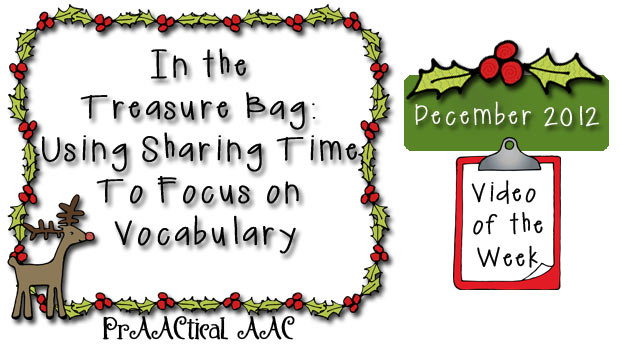
Over the past few months, we’ve been advocating for a multi-stage process for vocabulary teaching that begins with focused (aided) language stimulation and explicit instruction. The approach we described then moves into engaging practice activities while we continue to provide exposure and opportunities for retrieval, with periodic comprehension checks. This cycle allows SLPs to make use of research-based strategies in their semantic intervention and get the best outcomes for their AAC learners. So, when we came across this video about how to use ‘Sharing Time’ to build vocabulary, we knew we wanted to share it. It describes a classroom activity that could also be adapted for therapy groups in which students take turns bringing in an time from home to share with the class. We love the visual support that helps the students know what to talk about. It is a great reminder that visual supports are part of good... [Read More...]
December 28, 2012
by Carole Zangari -
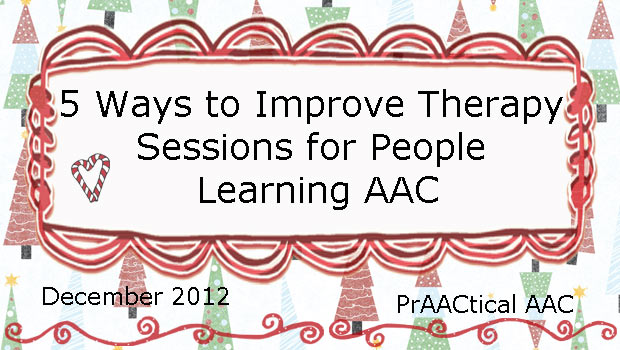
1. Start therapy as soon as you see the client: Savvy SLPs don’t waste a single second of therapy time. As soon as she saw 4 year-old Jonah in the waiting room, Chloe Clinician started sprinkling him with practice opportunities. They used vocalizations and gestures to greet other people. He ‘signed in’ at the front desk using a sheet she made up for Jonah to trace the first letter of his name. She blocked the door with her foot until he told her to ‘open’ and delayed his access to the beloved elevator button until he asked to go ‘up.’ By the time Jonah got to his therapy room, he had practiced skills in 5 different areas. This makes a clinical supervisor’s heart sing! 2. Speak AAC whenever you talk to the client. We’ve been shouting this from the virtual rooftops for quite awhile, but for those who missed it,... [Read More...]
December 22, 2012
by Robin Parker -
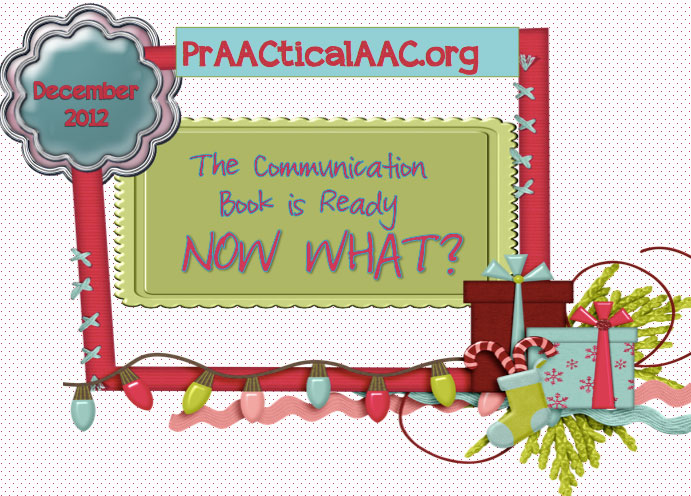
The Communication Book is Ready… Now What? The fun begins…. Yes, we really do think that TEACHING a learner to USE the communication book is FUN. We get to participate in lots of meaningful language experiences, we get to be creative, we get to watch language blossom, and we get to be surprised by the communication competence ALL of our learners show us after prAACtice, prAACtice, and for some more prAACtice . The best way to get started with communication book teaching is to begin by trying out different teaching tips, strategies, and resources and find out what works best. Each communication dyad (communicator & communication partner) is different so the combination of strategies that will work will vary but at the core of the teaching process, there should be fun, motivation, and of course progress. STRATEGIES and CONSIDERATIONS Aided Language Input (ALI)– We can not say enough about... [Read More...]
December 21, 2012
by Carole Zangari -
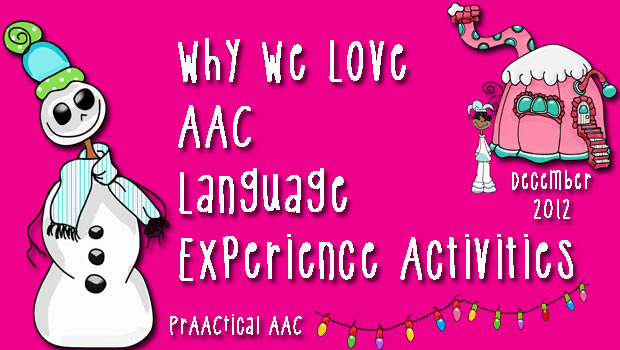
We love hearing the ways in which SLPs are using language experience activities in their therapy. That’s why we woke to big smiles today in hearing the story of a clinician who was having fun teaching the word ALL with goldfish crackers. Her little AAC friends could ask for a cracker and get one, or ask for ALL and get a pre-packaged portion. The power of contrast works in our favor in times like these. And it could easily be done with puzzle pieces or Lego blocks or any number of things. We can highlight it when we ALL leave the room or play a game as a group. Families can get in on the action, too. They can check to see if they have ALL the items from a list in the shopping cart or if they’ve put away ALL the groceries or laundry. Repetition with variety: another of... [Read More...]









